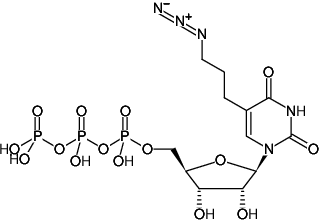Preparation of randomly Azide-modified RNA probes by in vitro transcription with 5-Azido-C3-UTP
| Cat. No. | Amount | Price (EUR) | Buy / Note |
|---|---|---|---|
| RNT-101-AZ | 25 reactions x 20 μl | 306,10 | Add to Basket/Quote Add to Notepad |

For general laboratory use.
Shipping: shipped on gel packs
Storage Conditions: store at -20 °C
avoid freeze/thaw cycles
Shelf Life: 12 months
Description:
HighYield T7 Azide RNA Labeling Kit (UTP-based) is designed to produce randomly Azide-modified RNA probes via in vitro transcription. Such probes are ideally suited for in situ hybridization, Northern Blot or crosslinking experiments.
5-Azido-C3-UTP is efficiently incorporated into RNA as substitute for its natural counterpart UTP using an optimized reaction buffer and T7 RNA Labeling Polymerase Mix. 35 % 5-Azido-C3-UTP substitution typically results in an optimal balance between reaction and labeling efficiency.
Individual optimization of 5-Azido-C3-UTP/UTP ratio however, can easily be achieved with the single nucleotide format.
The resulting Azide-modified RNA probe can subsequently be labeled by copper-free Click Chemistry with Dibenzocyclooctyne (DBCO)-functionalized detection reagents (e.g DBCO-functionalized fluorescent dyes or (Desthio)Biotin) thereby forming a stable, covalently labeled RNA probe[1].
The kit contains sufficient reagents for 25 labeling reactions of 20 μl each (35 % 5-Azido-C3-UTP substitution, 1 mM ATP, GTP, CTP, 0.65 mM UTP, 0.35 mM 5-Azido-C3-UTP).
Content:
HighYield T7 RNA Labeling Polymerase Mix
2x 40 μl, incl. RNase inhibitor and 50 % glycerol (v/v)
HighYield T7 Reaction Buffer
1x 200 μl (10x), HEPES-based
ATP - Solution
1x 100 μl (100 mM)
GTP - Solution
1x 100 μl (100 mM)
CTP - Solution
1x 100 μl (100 mM)
UTP - Solution
1x 100 μl (100 mM)
5-Azido-C3-UTP
1x 20 μl (10 mM)
T7 G-initiating control template (1.4 kbp)
1x 10 μl (200 ng/μl), 1.4 kbp PCR fragment plus T7 class III phi6.5 promotor resulting in approx. 1400 nt RNA transcript
PCR-grade water
1x 1.2 ml
DTT
1x 150 μl (100 mM)
To be provided by user
T7 Promotor-containing DNA template
DBCO-functionalized detection molecule
RNA purification tools
RNAse-free DNAse I (optional)
1. Important Notes (Read before starting)
1.1 Prevention of RNAse contamination
Although a potent RNase Inhibitor is included, creating a RNAse-free work environment and maintaining RNAse-free solutions is critical for performing successful in vitro transcription reactions. We therefore recommend
1.2 Template requirements
T7 class III phi6.5 promotor
5'-TAATACGACTCACTATAGNN...-3’
Bold: First base incorporated into RNA, NN: ideally CG
or
T7 class II phi2.5 promotor
5'-TAATACGACTCACTATTAGNN...-3'
Bold: First base incorporated into RNA, NN: ideally CG
2. Preparation of working solutions
2.1 Preparation of 10 mM ATP/CTP/GTP working solution
2.2 Preparation of 10 mM UTP working solution
3. In vitro Transcription protocol
The protocol is optimized for 0.5 μg - 1 μg DNA template.
An optimal balance between reaction and labeling efficiency is typically achieved with 35% 5-Azido-C3-UTP substitution following the standard protocol below however, individual optimization might improve results for individual applications.
| Component | Volume | Final concenctration |
| PCR-grade water | X μl | |
| HighYield T7 Reaction Buffer (10x) | 2 μl | 1x |
| 100 mM DTT | 2 μl | |
| 10 mM ATP/CTP/ GTP working solution (s. 2.1) | 2 μl | 1 mM |
| 10 mM UTP working solution (s. 2.2) | 1.3 μl | 0.65 mM |
| 10 mM 5-Azido-C3-UTP | 0.7 μl | 0.35 mM |
| Template DNA | X μl | 0.5 - 1 μg |
| HighYield T7 RNA Labeling Polymerase Mix | 2 μl | |
| Total volume | 20 μl |
Please note: Reagents for the following steps are not provided within this kit.
DNA template removal (optional)
Depending on the down-stream application of labeled RNA probe, removal of template DNA might be required. We recommend a salt-resistant, high efficiency DNAase such as Turbo™DNAse (ThermoFisher). Follow the manufacturer instructions.
General protocol for Copper-free CLICK labeling of Azide-modified RNA
For a detailled protocol, please refer to our background information: https://www.jenabioscience.com/images/741d0cd7d0/Click_Labeling_Azide_RNA.pdf
Related products: 5-Azido-C3-UTP, #NU-157
BIOZ Product Citations:
Selected References:
[1] Miller et al. (2018) Near-infrared fluorescent northern blot. RNA 24(12):1871.